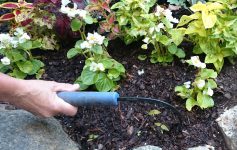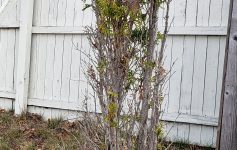Last winter as I sat by my patio door, cup of coffee in hand, looking over the pond in my wintry backyard, I noticed a furry black creature walking down my frozen stream bed. My initial thought: oh my cat Minuit is out on his morning stroll around the pond. But then it hit me, he is in his comfy bed by the fireplace. On second look I realized this creature had short legs, a longer neck and different shaped head than my Minuit. I had just spotted a mink!
It was not until the spring that I came to realize what havoc this creature delivered to my fish population. He cleaned me out! When my spring pond clean up time arrived, we found not one trace of fish: koi, goldfish or shibunkin weathered over in my pond! It was then I began to read about these sly creatures. Living in a wooded area bordered by wetlands, I came to understand that mink are quite prevalent. Never even gave a thought to this before my sighting. I worried more about fischers, snapper turtles and blue heron. Oh no, another predator to add to my pond worry list.
In the pond trade they call them “water wolves” And wolves they are. Mink are incredibly efficient catching their prey and do so swimming in water! So now I was understanding the impact my wetland perimeter has on their presence. Minks are known to travel 1mile from their creek or water territory to hunt. Speaking to local trappers I found mink are common in the water, wet woodland areas of our region, but incredibly sly and difficult to trap. So their population can grow. And for those of you experiencing this problem, unlikely it will go away soon.
Remarkably mink can take out koi much larger than their own bodies. Water garden professionals indicate they capture the fish and drag it out of the pond. The months when the pond water is cold say, around 50 degrees and below, October through April, are the most prevalent months for minks to hunt. The slow metabolisms of the fish leave them vulnerable as they barely move, let alone out swim a mink.
And unfortunately for our ornamental pond fish, their bright colors are like the flashing neon sign for mink: Joe’s Pond Eat Here! Resolving the problem is not an easy one. Some pond professionals suggest using an eco-friendly black dye in the pond when the water begins to turn colder…thus camouflaging the fish. But I love watching my fish during the waning fall months and frankly purchase them for their color. There are many hard structure canopies to install over your pond suggested by water garden professionals across the country. But again, these deter from my winter landscape enjoyment. I have invited local trappers to help with my problem. Trapping is an age old endeavor that has economical benefits to many local families in our region.
And lastly, if my fish population is gone this spring, I merely purchase new little koi, shibunkins and goldfish to balance my ecosystem, watch them grow, and enjoy their company for the season. I just stay away from the expensive, large ornamental fish. As the movie the Lion King suggests such is: The Circle of Life.



